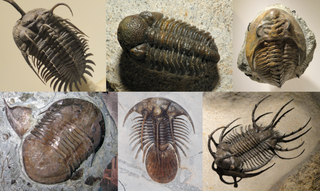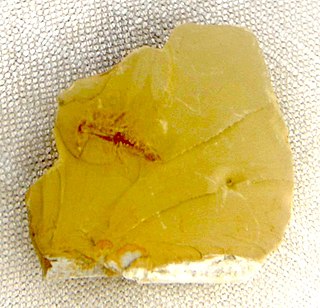
Agnostida are an order of extinct arthropods which have classically been seen as a group of highly modified trilobites, though some recent research has doubted this placement. Regardless, they appear to be close relatives as part of the Artiopoda. They are present in the Lower Cambrian fossil record along with trilobites from the Redlichiida, Corynexochida, and Ptychopariida orders, and were highly diverse throughout the Cambrian. Agnostidan diversity severely declined during the Cambrian-Ordovician transition, and the last agnostidans went extinct in the Late Ordovician.

Trilobites are extinct marine arthropods that form the class Trilobita. Trilobites form one of the earliest known groups of arthropods. The first appearance of trilobites in the fossil record defines the base of the Atdabanian stage of the Early Cambrian period and they flourished throughout the lower Paleozoic before slipping into a long decline, when, during the Devonian, all trilobite orders except the Proetida died out. The last extant trilobites finally disappeared in the mass extinction at the end of the Permian about 251.9 million years ago. Trilobites were among the most successful of all early animals, existing in oceans for almost 270 million years, with over 22,000 species having been described.
A troglodyte is a human cave dweller, from the Greek trogle 'hole, mouse-hole' and dyein 'go in, dive in'.

The Emu Bay Shale is a geological formation in Emu Bay, South Australia, containing a major Konservat-Lagerstätte. It is one of two in the world containing Redlichiidan trilobites. The Emu Bay Shale is dated as Cambrian Series 2, Stage 4, correlated with the upper Botomian Stage of the Lower Cambrian.

Anomalocaris is an extinct genus of radiodont, an order of early-diverging stem-group arthropods.

Arachnomorpha is a proposed subdivision or clade of Arthropoda, comprising the group formed by the trilobites and their close relatives (Artiopoda), Megacheira and chelicerates. Under this proposed classification scheme, Arachnomorpha is considered the sister group to Mandibulata.
Brongnartia can refer to:
Enrollment or enrolment may refer to:

Naraoia is a genus of small to average size marine arthropods within the family Naraoiidae, that lived from the early Cambrian to the late Silurian period. The species are characterized by a large alimentary system and sideways oriented antennas.

Cindarella is genus of trilobite-like Cambrian arthropod known from the Chengjiang biota of China. It is classified in the stem group of trilobites (Artiopoda) in the clade Xandarellida, along with Phytophilaspis, Sinoburius, and Xandarella.
The cephalon is the head section of an arthropod. It is a tagma, i.e., a specialized grouping of arthropod segments. The word cephalon derives from the Greek κεφαλή (kephalē), meaning "head".

Tegopelte gigas is a species of large soft-bodied arthropod known from two specimens from the Burgess Shale. Trackways that may have been produced by this organism or a close relative are known from the Kicking Horse Shale, stratigraphically below its body fossil occurrences. T. gigas is the only species classified under the genus Tegopelte. It is usually classified under its own family Tegopeltidae, but is sometimes placed under the family Naraoiidae. It is currently considered a member of Conciliterga within the Artiopoda.

Paleontology in Wisconsin refers to paleontological research occurring within or conducted by people from the U.S. state of Wisconsin. The state has fossils from the Precambrian, much of the Paleozoic, and the later part of the Cenozoic. Most of the Paleozoic rocks are marine in origin. Because of the thick blanket of Pleistocene glacial sediment that covers the rock strata in most of the state, Wisconsin’s fossil record is relatively sparse. In spite of this, certain Wisconsin paleontological occurrences provide exceptional insights concerning the history and diversity of life on Earth.
Kazachstania may refer to:
Trilobite larva may refer to juvenile forms (larvae) of multiple unrelated groups of animals:

Squamacula is an extinct artiopodan arthropod from the Cambrian Series 2. The type species S. clypeata was described in 1997 from the Chengjiang biota of Yunnan, China. At the time of description there were only two known specimens of S. clypeata, but now there are at least six known specimens. In 2012 a second species S. buckorum was described from the Emu Bay Shale of Australia.
This page is based on this
Wikipedia article Text is available under the
CC BY-SA 4.0 license; additional terms may apply.
Images, videos and audio are available under their respective licenses.









